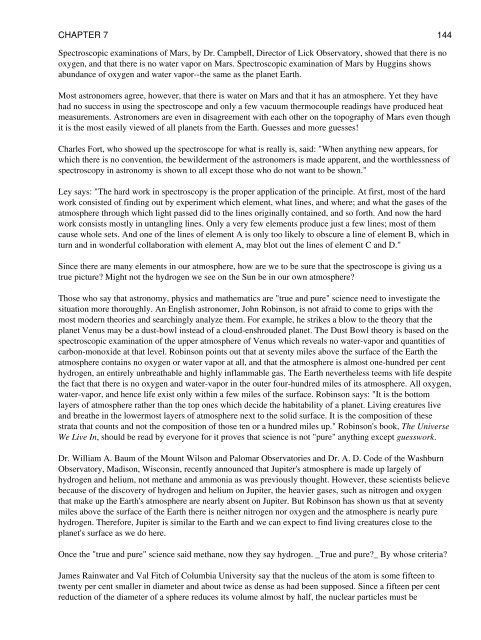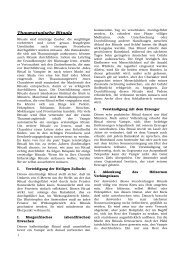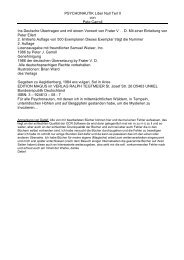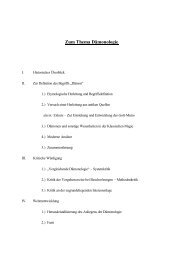CHAPTER 2 CHAPTER 3 CHAPTER 1 CHAPTER 2 CHAPTER 3 ...
CHAPTER 2 CHAPTER 3 CHAPTER 1 CHAPTER 2 CHAPTER 3 ...
CHAPTER 2 CHAPTER 3 CHAPTER 1 CHAPTER 2 CHAPTER 3 ...
Create successful ePaper yourself
Turn your PDF publications into a flip-book with our unique Google optimized e-Paper software.
<strong>CHAPTER</strong> 7 144<br />
Spectroscopic examinations of Mars, by Dr. Campbell, Director of Lick Observatory, showed that there is no<br />
oxygen, and that there is no water vapor on Mars. Spectroscopic examination of Mars by Huggins shows<br />
abundance of oxygen and water vapor--the same as the planet Earth.<br />
Most astronomers agree, however, that there is water on Mars and that it has an atmosphere. Yet they have<br />
had no success in using the spectroscope and only a few vacuum thermocouple readings have produced heat<br />
measurements. Astronomers are even in disagreement with each other on the topography of Mars even though<br />
it is the most easily viewed of all planets from the Earth. Guesses and more guesses!<br />
Charles Fort, who showed up the spectroscope for what is really is, said: "When anything new appears, for<br />
which there is no convention, the bewilderment of the astronomers is made apparent, and the worthlessness of<br />
spectroscopy in astronomy is shown to all except those who do not want to be shown."<br />
Ley says: "The hard work in spectroscopy is the proper application of the principle. At first, most of the hard<br />
work consisted of finding out by experiment which element, what lines, and where; and what the gases of the<br />
atmosphere through which light passed did to the lines originally contained, and so forth. And now the hard<br />
work consists mostly in untangling lines. Only a very few elements produce just a few lines; most of them<br />
cause whole sets. And one of the lines of element A is only too likely to obscure a line of element B, which in<br />
turn and in wonderful collaboration with element A, may blot out the lines of element C and D."<br />
Since there are many elements in our atmosphere, how are we to be sure that the spectroscope is giving us a<br />
true picture? Might not the hydrogen we see on the Sun be in our own atmosphere?<br />
Those who say that astronomy, physics and mathematics are "true and pure" science need to investigate the<br />
situation more thoroughly. An English astronomer, John Robinson, is not afraid to come to grips with the<br />
most modern theories and searchingly analyze them. For example, he strikes a blow to the theory that the<br />
planet Venus may be a dust-bowl instead of a cloud-enshrouded planet. The Dust Bowl theory is based on the<br />
spectroscopic examination of the upper atmosphere of Venus which reveals no water-vapor and quantities of<br />
carbon-monoxide at that level. Robinson points out that at seventy miles above the surface of the Earth the<br />
atmosphere contains no oxygen or water vapor at all, and that the atmosphere is almost one-hundred per cent<br />
hydrogen, an entirely unbreathable and highly inflammable gas. The Earth nevertheless teems with life despite<br />
the fact that there is no oxygen and water-vapor in the outer four-hundred miles of its atmosphere. All oxygen,<br />
water-vapor, and hence life exist only within a few miles of the surface. Robinson says: "It is the bottom<br />
layers of atmosphere rather than the top ones which decide the habitability of a planet. Living creatures live<br />
and breathe in the lowermost layers of atmosphere next to the solid surface. It is the composition of these<br />
strata that counts and not the composition of those ten or a hundred miles up." Robinson's book, The Universe<br />
We Live In, should be read by everyone for it proves that science is not "pure" anything except guesswork.<br />
Dr. William A. Baum of the Mount Wilson and Palomar Observatories and Dr. A. D. Code of the Washburn<br />
Observatory, Madison, Wisconsin, recently announced that Jupiter's atmosphere is made up largely of<br />
hydrogen and helium, not methane and ammonia as was previously thought. However, these scientists believe<br />
because of the discovery of hydrogen and helium on Jupiter, the heavier gases, such as nitrogen and oxygen<br />
that make up the Earth's atmosphere are nearly absent on Jupiter. But Robinson has shown us that at seventy<br />
miles above the surface of the Earth there is neither nitrogen nor oxygen and the atmosphere is nearly pure<br />
hydrogen. Therefore, Jupiter is similar to the Earth and we can expect to find living creatures close to the<br />
planet's surface as we do here.<br />
Once the "true and pure" science said methane, now they say hydrogen. _True and pure?_ By whose criteria?<br />
James Rainwater and Val Fitch of Columbia University say that the nucleus of the atom is some fifteen to<br />
twenty per cent smaller in diameter and about twice as dense as had been supposed. Since a fifteen per cent<br />
reduction of the diameter of a sphere reduces its volume almost by half, the nuclear particles must be






